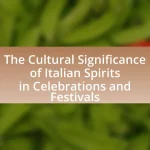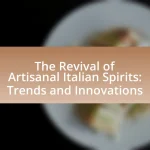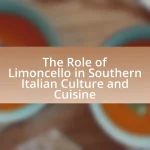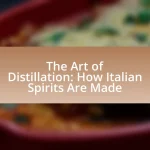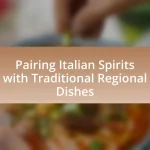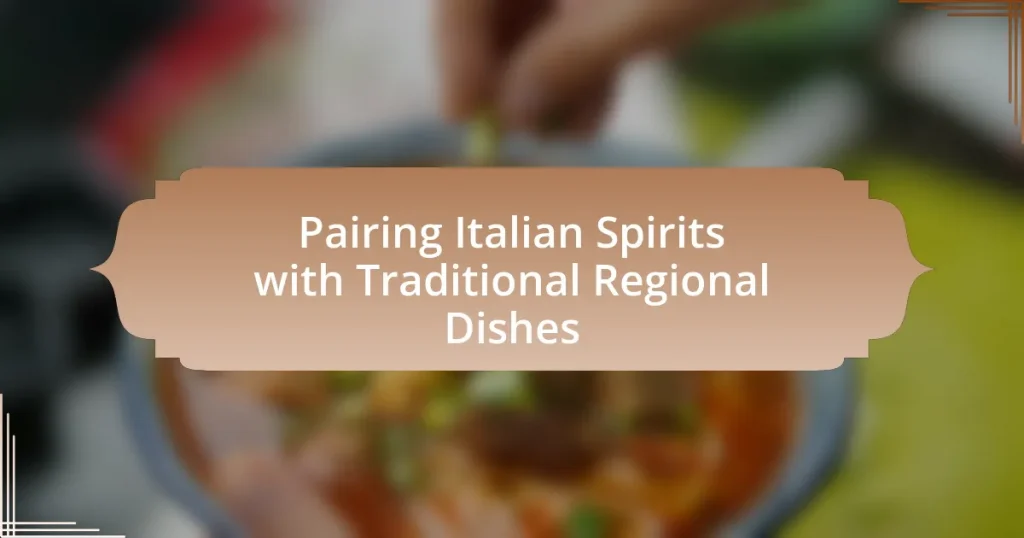The article focuses on the pairing of Italian spirits with traditional regional dishes, highlighting the significance of these distilled beverages in Italy’s culinary traditions. It explores various types of Italian spirits, including Grappa, Limoncello, Amaro, and Vermouth, detailing their unique production methods, flavor profiles, and regional influences. The article emphasizes the importance of pairing spirits with food to enhance the dining experience, providing insights into best practices, common mistakes, and classic pairings that reflect Italy’s diverse agricultural heritage and culinary artistry. Additionally, it offers tips for experimenting with pairings and resources for further learning about Italian spirits and their culinary applications.

What are Italian Spirits and Their Significance in Culinary Traditions?
Italian spirits are distilled alcoholic beverages that play a significant role in the country’s culinary traditions, often enhancing the flavors of regional dishes. These spirits, such as grappa, limoncello, and amaro, are typically made from local ingredients and reflect the diverse agricultural heritage of Italy. For instance, grappa is produced from the pomace of grapes, showcasing the importance of viticulture in Italian culture. The significance of these spirits lies in their use as digestifs, aperitifs, and flavoring agents in cooking, which not only complement traditional recipes but also embody the essence of Italian hospitality and culinary artistry.
How do Italian spirits differ from other types of spirits?
Italian spirits differ from other types of spirits primarily in their unique production methods and flavor profiles, which are often influenced by regional ingredients and traditions. For example, Italian spirits like grappa and limoncello are made from local grapes and lemons, respectively, showcasing the country’s agricultural diversity. Additionally, many Italian spirits are characterized by their use of herbs and botanicals, as seen in products like amaro, which is crafted through a complex infusion process that highlights regional flavors. This emphasis on local ingredients and traditional techniques sets Italian spirits apart from other global varieties, which may not prioritize such regional specificity or artisanal methods.
What are the main categories of Italian spirits?
The main categories of Italian spirits are Grappa, Limoncello, Amaro, and Vermouth. Grappa is a pomace brandy made from the leftovers of winemaking, while Limoncello is a lemon liqueur originating from Southern Italy. Amaro refers to a variety of herbal bitters, often consumed as a digestif, and Vermouth is a fortified wine flavored with various botanicals. These categories represent the diversity of Italian spirits, each with unique production methods and flavor profiles that reflect regional traditions.
How are Italian spirits traditionally produced?
Italian spirits are traditionally produced through a process that involves fermentation, distillation, and aging. The production begins with the fermentation of fruits, grains, or herbs, which converts sugars into alcohol. This fermented mash is then distilled, typically using pot stills or column stills, to separate the alcohol from the water and other components. After distillation, many Italian spirits undergo aging in wooden barrels, which imparts unique flavors and characteristics. For example, grappa is made from grape pomace and is often unaged, while vermouth is fortified with herbs and spices and may be aged to enhance its complexity. This traditional method reflects Italy’s rich agricultural heritage and regional diversity, contributing to the distinct profiles of spirits like limoncello, amaro, and sambuca.
Why is pairing spirits with food important in Italian culture?
Pairing spirits with food is important in Italian culture because it enhances the dining experience and reflects regional traditions. In Italy, each region has its own unique spirits, such as grappa or limoncello, which are traditionally consumed with specific dishes to complement flavors and aromas. This practice is rooted in the belief that the right spirit can elevate the taste of food, creating a harmonious balance that showcases local ingredients and culinary heritage. For example, pairing a robust red wine with hearty pasta dishes from Tuscany exemplifies how regional pairings are integral to Italian gastronomy, emphasizing the connection between food, drink, and cultural identity.
What role do spirits play in enhancing the dining experience?
Spirits play a significant role in enhancing the dining experience by complementing and elevating the flavors of food. When paired correctly, spirits such as grappa or amaro can enhance the taste profile of traditional Italian dishes, creating a harmonious balance that enriches the overall meal. For instance, the herbal notes of amaro can accentuate the richness of a meat dish, while the fruity undertones of grappa can provide a refreshing contrast to creamy sauces. This synergy between spirits and food not only enhances flavor but also contributes to the cultural experience of dining, as it reflects regional traditions and culinary practices.
How does regionality influence spirit and food pairings?
Regionality significantly influences spirit and food pairings by dictating the local ingredients, flavors, and culinary traditions that define a region’s cuisine. For example, in Italy, the use of regional spirits like Grappa from the North pairs well with rich, hearty dishes such as risotto, while lighter spirits like Limoncello from the South complement fresh seafood and citrus-based dishes. This alignment between local spirits and traditional foods enhances the overall dining experience, as the flavors of the spirit often mirror or elevate the characteristics of the regional dishes. The historical context of these pairings is rooted in the agricultural practices and cultural heritage of each area, which shapes both the production of spirits and the preparation of food.

What are the Key Italian Spirits to Consider for Pairing?
Key Italian spirits to consider for pairing include Grappa, Amaro, Limoncello, and Vermouth. Grappa, a pomace brandy, complements rich dishes like risotto and game meats due to its robust flavor. Amaro, an herbal liqueur, pairs well with savory dishes and desserts, enhancing the meal’s complexity. Limoncello, a lemon liqueur, is ideal for light seafood dishes and desserts, providing a refreshing contrast. Vermouth, a fortified wine, works well with antipasti and can enhance the flavors of various Italian appetizers. Each spirit’s unique characteristics align with traditional regional dishes, making them essential for pairing.
What are the most popular Italian spirits used in pairings?
The most popular Italian spirits used in pairings include Grappa, Amaretto, Limoncello, and Vermouth. Grappa, a distilled spirit made from grape pomace, is often paired with rich cheeses and desserts, enhancing the flavors of both. Amaretto, an almond-flavored liqueur, complements desserts like tiramisu and panna cotta, providing a sweet contrast. Limoncello, a lemon liqueur, is typically served with seafood dishes, balancing the flavors with its citrus notes. Vermouth, a fortified wine flavored with various botanicals, is commonly used in cocktails and pairs well with antipasti, enhancing the overall dining experience. These spirits are integral to Italian culinary traditions, showcasing regional flavors and enhancing food pairings.
What is the flavor profile of Grappa and how does it pair with food?
Grappa has a complex flavor profile characterized by strong, aromatic notes of grape pomace, which can include hints of fruit, floral, and herbal undertones. The alcohol content typically ranges from 35% to 60%, contributing to its bold and warming sensation. Grappa pairs well with a variety of foods; it complements rich cheeses, dark chocolate, and fruit-based desserts, enhancing their flavors through its aromatic qualities. Additionally, it can be enjoyed alongside traditional Italian dishes such as risotto or grilled meats, where its robust character balances the richness of the food.
How does Limoncello complement traditional dishes?
Limoncello complements traditional dishes by enhancing flavors and providing a refreshing contrast to rich and savory foods. Its bright citrus notes cut through the heaviness of dishes like pasta with cream sauces or fried seafood, balancing the palate. Additionally, Limoncello is often served as a digestif, aiding digestion after a meal, which is a common practice in Italian dining culture. This pairing is rooted in regional traditions, particularly in Southern Italy, where Limoncello is produced, making it a culturally significant accompaniment to local cuisine.
What lesser-known Italian spirits should be explored?
Lesser-known Italian spirits that should be explored include Grappa, Amaro, and Limoncello. Grappa, a pomace brandy, is produced from the leftover grape skins, seeds, and stems after winemaking, and it varies in flavor depending on the grape variety used. Amaro, an herbal liqueur, is often consumed as a digestif and features a complex blend of herbs, roots, and spices, with regional variations such as Amaro Montenegro from Emilia-Romagna. Limoncello, a lemon liqueur from the Amalfi Coast, is made from lemon zest, alcohol, water, and sugar, offering a refreshing taste that pairs well with desserts. These spirits reflect Italy’s diverse regional traditions and enhance the culinary experience when paired with traditional dishes.
What is the unique character of Amaro and its pairing potential?
Amaro is characterized by its complex blend of bitter, sweet, herbal, and aromatic flavors, which result from a variety of botanicals, roots, and spices used in its production. This unique profile allows Amaro to pair exceptionally well with a wide range of traditional Italian dishes, enhancing flavors and providing a balanced contrast. For instance, the bitterness of Amaro complements rich, fatty foods like braised meats and cheeses, while its sweetness can harmonize with desserts, such as panna cotta or chocolate-based dishes. The versatility of Amaro in pairing is supported by its regional variations, each offering distinct flavor profiles that align with local culinary traditions, making it a valuable addition to Italian dining experiences.
How can Vermouth enhance specific regional dishes?
Vermouth can enhance specific regional dishes by adding depth and complexity through its unique blend of botanicals and flavors. For example, in Italian cuisine, vermouth complements dishes like risotto and braised meats by providing herbal notes that elevate the overall taste profile. The use of dry vermouth in seafood dishes, such as spaghetti alle vongole, enhances the brininess of the clams while balancing the richness of the pasta. Additionally, sweet vermouth can enrich desserts like tiramisu, contributing a layer of aromatic sweetness that harmonizes with coffee and cocoa flavors. These pairings are supported by the traditional Italian practice of using fortified wines to enhance culinary experiences, demonstrating vermouth’s integral role in regional gastronomy.
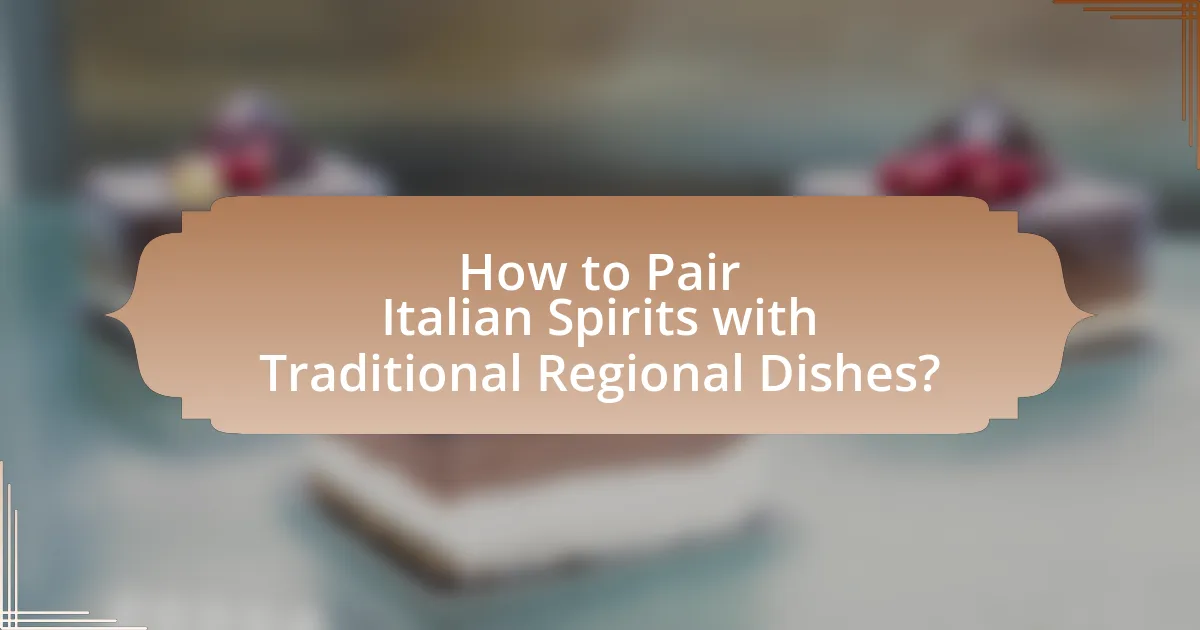
How to Pair Italian Spirits with Traditional Regional Dishes?
To pair Italian spirits with traditional regional dishes, one should consider the flavor profiles of both the spirit and the dish. For example, pairing a robust Amaro with rich, meaty dishes from Northern Italy complements the bitterness of the spirit with the savory flavors of the food. In contrast, lighter spirits like Limoncello work well with seafood dishes from the coastal regions, enhancing the freshness of the ingredients. This approach is validated by the Italian culinary tradition, which emphasizes harmony between food and drink, ensuring that the characteristics of each enhance the overall dining experience.
What are the best practices for pairing spirits with food?
The best practices for pairing spirits with food include considering the flavor profiles, balancing intensity, and complementing or contrasting elements. For instance, pairing a robust whiskey with a rich meat dish enhances the meal’s depth, while a light gin can complement seafood by highlighting its freshness. Additionally, regional traditions often guide pairings; for example, Italian spirits like Grappa are traditionally served with desserts to balance sweetness. These practices are supported by culinary principles that emphasize harmony and contrast, ensuring a well-rounded dining experience.
How do flavor profiles of spirits and dishes interact?
Flavor profiles of spirits and dishes interact through complementary and contrasting elements that enhance the overall tasting experience. For instance, the herbal notes in a gin can elevate the flavors of a dish like risotto, while the sweetness of a dessert wine can balance the acidity of a citrus-based dish. This interaction is supported by the principle of flavor pairing, which suggests that ingredients with similar flavor compounds tend to work well together, as seen in the pairing of amaro with rich, savory meats. Additionally, the texture and intensity of both the spirit and the dish play crucial roles; a bold whiskey can stand up to a hearty stew, creating a harmonious balance.
What are common mistakes to avoid when pairing?
Common mistakes to avoid when pairing Italian spirits with traditional regional dishes include ignoring flavor profiles, mismatching intensity, and overlooking regional compatibility. Ignoring flavor profiles can lead to combinations that clash rather than complement; for example, pairing a bitter amaro with a delicate seafood dish can overwhelm the flavors. Mismatching intensity occurs when a robust spirit overshadows a subtle dish, such as serving a high-proof grappa with a light pasta, which can mask the dish’s nuances. Overlooking regional compatibility means failing to consider the traditional pairings that have evolved over time, such as pairing a Tuscan Chianti with a hearty ribollita, which enhances both the spirit and the dish. These mistakes can detract from the overall dining experience and diminish the appreciation of both the spirits and the cuisine.
What are some classic pairings of spirits and regional dishes?
Classic pairings of Italian spirits and regional dishes include Grappa with Gnocchi, Limoncello with Caprese Salad, and Amaro with Tiramisu. Grappa, a distilled spirit made from grape pomace, complements the soft texture of Gnocchi, enhancing the dish’s flavors. Limoncello, a lemon liqueur from the Amalfi Coast, pairs well with the fresh ingredients of Caprese Salad, balancing the richness of mozzarella with its citrus notes. Amaro, a herbal liqueur, serves as a perfect digestif alongside Tiramisu, as its complex flavors contrast with the dessert’s sweetness, creating a harmonious finish to the meal. These pairings reflect regional traditions and enhance the dining experience through complementary flavors.
How does Grappa pair with Northern Italian cuisine?
Grappa pairs exceptionally well with Northern Italian cuisine due to its strong, aromatic profile that complements rich and hearty dishes typical of the region. The high alcohol content and complex flavors of Grappa enhance the taste of traditional Northern Italian foods, such as risottos, polentas, and game meats. For instance, the herbal and fruity notes in Grappa can balance the creaminess of a risotto or the savory flavors of braised meats, creating a harmonious dining experience. Additionally, Grappa is often enjoyed as a digestif, aiding digestion after a meal, which aligns with the culinary customs of Northern Italy where meals are often rich and filling.
What dishes are best complemented by Limoncello in Southern Italy?
Limoncello is best complemented by seafood dishes, particularly grilled fish and shrimp, as well as light pasta dishes such as spaghetti with lemon and olive oil. The citrus notes of Limoncello enhance the freshness of seafood, making it a popular choice in Southern Italy. Additionally, desserts like lemon sorbet and panna cotta pair well, as the sweetness balances the tartness of the liqueur. This pairing is rooted in the culinary traditions of the Amalfi Coast, where Limoncello originated, highlighting its role in enhancing the flavors of local cuisine.
What tips can enhance the pairing experience?
To enhance the pairing experience of Italian spirits with traditional regional dishes, focus on complementary flavors and regional authenticity. Selecting spirits that share flavor profiles with the dish, such as pairing a herbal amaro with a rich, herb-infused pasta, can elevate the dining experience. Additionally, considering the regional origins of both the spirit and the dish ensures a harmonious match; for instance, pairing a Sicilian limoncello with a lemon-infused seafood dish highlights the local ingredients and traditions. Research indicates that flavor compatibility significantly influences taste perception, making thoughtful pairings essential for an enjoyable culinary experience.
How can one experiment with different pairings effectively?
To experiment with different pairings effectively, one should systematically test various combinations of Italian spirits and traditional regional dishes while documenting the sensory experiences. This method allows for a structured approach to identify which pairings enhance flavors and create a harmonious dining experience. For instance, pairing a robust Barolo with a rich Osso Buco can highlight the dish’s savory notes, while a lighter Prosecco may complement a seafood risotto. By keeping detailed notes on each pairing’s taste, aroma, and overall satisfaction, one can refine their choices based on personal preferences and feedback from others. This approach is supported by the principles of flavor pairing, which suggest that complementary tastes can elevate the dining experience.
What resources are available for learning more about Italian spirits and food pairings?
Books such as “The Oxford Companion to Italian Food” by Gillian Riley and “Italian Spirits: The Ultimate Guide” by Marco Pierini provide comprehensive insights into Italian spirits and their food pairings. Additionally, websites like Eater and Wine Enthusiast offer articles and guides that explore the nuances of pairing Italian spirits with traditional dishes. These resources are validated by their extensive coverage of Italian culinary traditions and expert contributions in the field.
